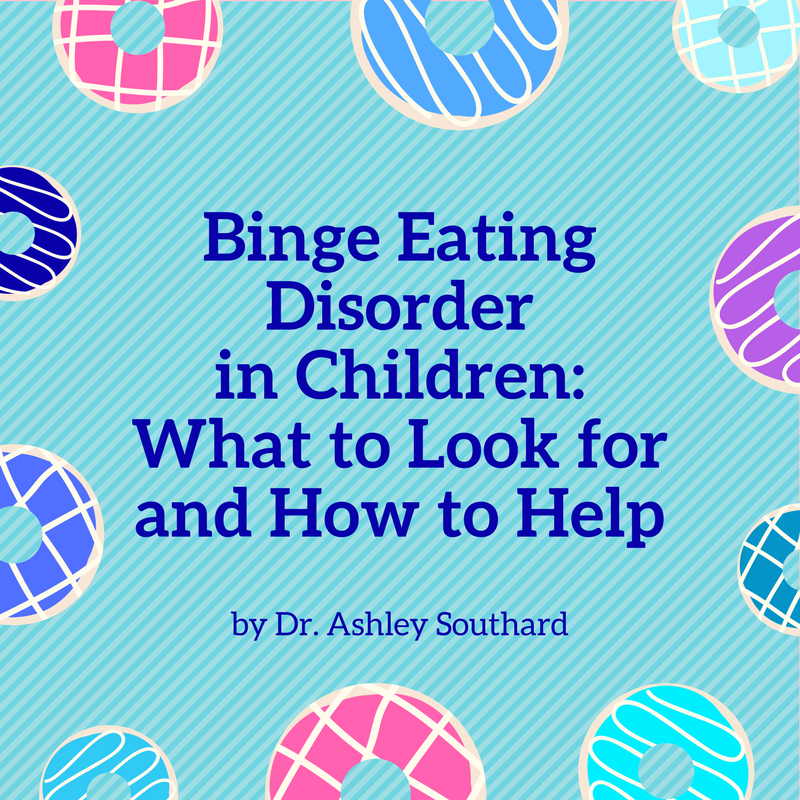Binge Eating Disorder in Children: What to Look For and How to Help
by
Binge eating disorder (BED) in kids and adolescents is an important topic that is just now starting to garner the attention of researchers and treatment professionals alike. With the recent addition of BED to the Diagnostic and Statistical Manual, 5th Edition, more people are now seeking to understand and heal from this very distressing ~ and very treatable ~ disorder. While it is well known that anorexia nervosa and bulimia nervosa commonly begin in late childhood/adolescence, BED also affects youth and can be an emotionally and, at times, physically debilitating experience when left untreated.
Prevalence
 Binge eating disorder affects about 1-2% of children and adolescents. While the average age of onset for BED is late teens/early 20s, young children and teens are also struggling with this disorder. Current research suggests that BED affects about 3.5% of adult women and 2% of adult men, but research has yet to provide data about the gender distribution of BED among youth. It is important to note that a much larger portion of the population struggles with sub-clinical BED, meaning they meet some, but not all, of the diagnostic criteria. While their disordered eating may not be diagnosable, it can be just as distressing and destructive as the full clinical disorder.
Binge eating disorder affects about 1-2% of children and adolescents. While the average age of onset for BED is late teens/early 20s, young children and teens are also struggling with this disorder. Current research suggests that BED affects about 3.5% of adult women and 2% of adult men, but research has yet to provide data about the gender distribution of BED among youth. It is important to note that a much larger portion of the population struggles with sub-clinical BED, meaning they meet some, but not all, of the diagnostic criteria. While their disordered eating may not be diagnosable, it can be just as distressing and destructive as the full clinical disorder.
Signs and Symptoms
Recognizing the signs and symptoms of binge eating disorder is crucial to the proper treatment of this illness. For adults and youth alike, BED is marked by recurrent episodes of binge eating, which are defined by eating a relatively large amount of food in a short period of time and feeling out of control during the binge episode. Additionally, binge eating episodes are associated with at least three of the following qualities: (1) eating more rapidly than normal; (2) eating until feeling uncomfortably full; (3) eating large amounts of food when not feeling physically hungry; (4) eating alone because of feeling embarrassed by the quantity of food being consumed; and/or (5) feeling disgusted, depressed, and/or guilty after bingeing. To be diagnosed with BED, a person must binge on average at least once a week for 3 months and not use compensatory behaviors, such as purging or excessive exercise, to balance out the caloric intake.
For parents and loved ones, spotting these binge eating symptoms in their children can be very difficult because the binge episodes are often done in isolation. The shame a person feels before, during, and after the binge episode compels them to hide their behaviors from others. Thus, it is helpful for parents to understand what other warning signs to watch for that may indicate a child or teen is struggling with binge eating. It is important to note that the occurrence of one of these symptoms on its own certainly may not warrant concern or indicate BED; it is the constellation of multiple signs that may indicate a child’s struggle with BED. While the following list of observable warning signs is not exhaustive, it does capture the most common signs that a child or teen may be struggling with BED:
 1) You find empty food wrappers in their bedroom, bathroom, backpack, car, or other places where the child may spend time alone. Oftentimes the wrappers are hidden, such that you may find them under the bed, stuffed in the back of a drawer, or strategically buried in the trash.
1) You find empty food wrappers in their bedroom, bathroom, backpack, car, or other places where the child may spend time alone. Oftentimes the wrappers are hidden, such that you may find them under the bed, stuffed in the back of a drawer, or strategically buried in the trash.
2) Your child seems to be obsessed with food, always talking about their next meal or snack, what they want to buy at the grocery store, which restaurant they want to go to next, etc. Many adult binge eaters report thinking about food the majority of the day, so it is likely that children struggling with binge eating are spending the majority of their cognitive energy also obsessing about food.
3) Your child eats unusually fast and consumes relatively large portions, or appears to eat very little while still gaining weight.
4) Your child seeks out food when emotionally distressed and/or overwhelmed, even when not physically hungry. When placed in the context of the aforementioned warning signs, seemingly innocent statements like, “I’ve had such a hard day; I need a cupcake,” or “Chips will help me feel better,” may be an indicator of disordered eating.
5) You observe age-inappropriate weight gain and/or weight fluctuations not accounted for by a medical condition or normative physical development. About 70% of adults struggling with binge eating disorder are also overweight or obese. As a result, many binge eaters also engage in frequent dieting in an attempt to lose weight, creating a chronic binge-diet-binge-diet cycle. This “yo-yo” dieting can result in noticeable and rapid changes to a person’s weight. While it is not yet known how many children with BED are also overweight or obese, it is reasonable to assume that the weight patterns in adult binge eaters are fairly comparable to those experienced in youth who binge eat.
6) Your child also shows signs of depression and/or anxiety. About half of all children with BED are also struggling with depression. This may appear in the form of avoiding school and other responsibilities, minimal socializing with friends or not engaging in age- appropriate extracurricular activities and hobbies, increased expression of anger or hostility, emotionally guarded, spending more time alone in bedroom and/or sleeping more, and not engaging in activities that were once enjoyable.
Causes of Binge Eating Disorder
There are many factors that contribute to the development of binge eating disorder, including biological/genetic, psychological, and nutritional.
A variety of biological and genetic components may put a child at-risk for developing binge eating disorder, including: brain chemistry, comorbid psychiatric conditions, and body shape/size. Newer research is investigating the effects of lower-than-normal serotonin levels that compel a person to crave and seek out excessive amounts of starchy foods (i.e., snacks, desserts) that help the body produce higher levels of serotonin. Additionally, preliminary research suggests that BED appears to have high comorbidity with Attention-Deficit/Hyperactivity Disorder (ADHD), resulting in a greater susceptibility to impulsive behaviors, such as binge eating. Lastly, children with naturally larger body shapes and sizes may be more likely than their peers with smaller/slimmer body shapes and sizes to experience body shame, which may lead to the ironic use of food to quell their body-related distress.
 Binge eating disorder is most typically driven by a host of psychological and emotional components that are then inappropriately managed with the misuse of food. Most notably, some form of trauma and/or significantly distressing experience(s) is very often at the root of BED. This may include: 1) Physical and/or emotional abuse; 2) Sexual abuse; 3) Emotional neglect; 4) High conflict or tension in the home; 5) Parental divorce or separation; loss of a parent; 6) Recurrent public humiliation; 7) Rejection by peers and/or loved ones; 8) Bullying; and/or 9) Life-threatening experience (e.g., car accident, natural disaster).
Binge eating disorder is most typically driven by a host of psychological and emotional components that are then inappropriately managed with the misuse of food. Most notably, some form of trauma and/or significantly distressing experience(s) is very often at the root of BED. This may include: 1) Physical and/or emotional abuse; 2) Sexual abuse; 3) Emotional neglect; 4) High conflict or tension in the home; 5) Parental divorce or separation; loss of a parent; 6) Recurrent public humiliation; 7) Rejection by peers and/or loved ones; 8) Bullying; and/or 9) Life-threatening experience (e.g., car accident, natural disaster).
When traumatic experiences like these go unprocessed and unresolved, a child or teen may feel very overwhelmed by their emotions and thoughts in response to the trauma, and then be inclined to “stuff” their emotions and needs much like they “stuff” themselves with excessive amounts of food.
In addition to the experience of trauma, many adults struggling with BED also report early life experiences in which they felt as though their emotions, needs, and wants were invalidated and/or minimized by the people most important to them (e.g., parents, siblings, extended family, coaches, friends). Phrases like, “Stop crying; you’re fine,” “You’re overreacting,” or “Quit being so dramatic,” can leave a child feeling like their emotional experience is not ok and that they are not safe to express what is going on inside for them. Thus, they may turn to food in an attempt to self-regulate the intense emotions they are feeling.
Lastly, a common childhood experience of adults struggling with binge eating is being put on a diet at a young age. While this may be an adult’s innocent, loving attempt to help an overweight child, what the child often feels is shame for their body ~ a sense that they’re not good enough because they’re not thin. This deep sense of shame, and the disappointment they fear they’ve caused their loved ones, can be a powerful trigger for binge eating.
Nutritionally, children and teens with BED may be surrounded by a pressure to eat “healthy” and/or diet, encouraged to avoid snack foods and desserts. While this sounds like a good way to help a child stop overeating and attain a healthy weight, it often backfires because it actually compels the child to want even more less-healthy foods.
How to Treat Binge Eating Disorder
 Thankfully, recovery from BED is absolutely possible! When high-quality professional support is coupled with healthy familial support, a child’s relationship with food can dramatically improve.
Thankfully, recovery from BED is absolutely possible! When high-quality professional support is coupled with healthy familial support, a child’s relationship with food can dramatically improve.
High-quality professional support involves a treatment team of eating disorder specialists to help the child and the family. This team often includes:
1) A psychologist/clinical therapist who specializes in binge eating disorder to help the child explore and process underlying emotional issues that may be driving the BED; and teach skills for more effectively managing distressing thoughts and emotions, particularly as they relate to BED;
2) A family therapist who works with the whole family system to provide education about BED, help the family develop a healthy relationship with food and movement, and facilitate important conversations about the issues underlying the child’s BED;
3) The child’s pediatrician to monitor the child’s physical health and growth throughout treatment;
4) A registered dietitian who specializes in binge eating disorder and can provide nutritional guidance and support without putting the child on any kind of restrictive diet; and
5) A psychiatrist, if psychiatric medication is recommended, to evaluate the effectiveness of medication and monitor possible side effects. Currently, Vyvanse, a stimulant medication indicated for the treatment of ADHD, is the only medication approved for the treatment of BED.
Additionally, healthy familial support is the best “medicine” for a child struggling with BED. Upon discovery of the disorder, it is imperative that the family respond to the child in an emotionally healthy, loving, and non-judgmental way. This can be accomplished in several ways, including but not limited to:
1) Talk about your concerns in a kind, respectful way. Use phrases like, “I love you so much and I want to help you feel better,” or “I am here for you. How can I support you?” or “You’re not alone in this; we’ll figure this out together.” Avoid commenting on the child’s weight, criticizing or teasing the child for his/her eating behaviors, or somehow conveying that s/he is doing something bad. Shame is not a motivator for change, so remain kind and loving in all of your discussions.
 2) Talk about feelings, yours and theirs. BED is not really about food, just like alcoholism is not really about alcohol; so help your child get to the root of what is really bothering them. You can role model this by talking about your own emotions more, and then ask your child questions about how they’re feeling. If this is challenging for you and/or your family, a family therapist can be instrumental in helping to facilitate these types of conversations.
2) Talk about feelings, yours and theirs. BED is not really about food, just like alcoholism is not really about alcohol; so help your child get to the root of what is really bothering them. You can role model this by talking about your own emotions more, and then ask your child questions about how they’re feeling. If this is challenging for you and/or your family, a family therapist can be instrumental in helping to facilitate these types of conversations.
3) Encourage a balanced relationship with food and movement. People in recovery from an eating disorder understand that all foods are okay in moderation; no foods are “off- limits” or “bad.” Additionally, they understand that pleasurable, unhealthy choices must be balanced out with pleasurable, healthy choices to maintain a strong, well-functioning body. Similarly, people in recovery also understand that exercise is about moving the body in ways that leave you feeling strong, empowered, flexible, calm, joyful, and connected within; exercise should never be about burning or earning calories.
4) Look at your own relationship with food and your body, and consider what you are modeling for your child. Many adults struggling with binge eating disorder report growing up in families where parents were also binge eating, chronically dieting, and/or constantly talking about their own weight. As you support your child in his/her own recovery process, make sure that your relationship with food is serving as a healthy model for your child to follow.
5) Follow all of the recommendations given to you by your treatment team. Trained professionals with experience treating binge eating disorder will know how to guide you and your child through the recovery process, so trust them and trust the process (even when it doesn’t feel good or feels counterintuitive).
If you or a loved one is supporting a child struggling with BED, please know that full recovery happens. Children, teens, and adults alike can absolutely restore balance in their relationship with food ~ we see it happen everyday!
 Dr. Ashley Southard is the Site Director and Clinical Therapist at A New Beginning in Scottsdale, AZ, where she specializes in the treatment of binge eating disorder, trauma/abuse, and relationship issues. She is also the Co-Founder and Program Director of TheHealthyWeighOut, a program specifically designed to help people struggling with Emotional and Binge Eating. You can follow her on Twitter at @drashleys, and Facebook at /anewbeginningaz and /thehealthyweighout.
Dr. Ashley Southard is the Site Director and Clinical Therapist at A New Beginning in Scottsdale, AZ, where she specializes in the treatment of binge eating disorder, trauma/abuse, and relationship issues. She is also the Co-Founder and Program Director of TheHealthyWeighOut, a program specifically designed to help people struggling with Emotional and Binge Eating. You can follow her on Twitter at @drashleys, and Facebook at /anewbeginningaz and /thehealthyweighout.
References
American Psychiatric Association. (2013). Diagnostic and statistical manual of mental disorders (5th ed.). Arlington, VA: American Psychiatric Publishing.
Nazar, B. P., Bernardes, B. A., Peachey, G., Sergeant, J., Mattos, P., & Treasure, J. (2016). The risk of eating disorders comorbid with attention-deficit/hyperactivity disorder: A systematic review and meta-analysis. International Journal of Eating Disorders, 49(12), 1045-1057.
Schaffer, J. (2015). Binge eating disorder statistics: Know the facts. Retrieved February 16, 2017 from http://www.healthline.com/health/eating-disorders/binge-eating-disorder-statistics.
van Strien, T, van der Zwaluw, C. S., & Engels, R. C. (2010). Emotional eating in adolescents: A gene (SLC6A4/5-HTT) – depressive feelings interaction analysis. Journal of Psychiatric Research, 44(15), 1035-1042.







